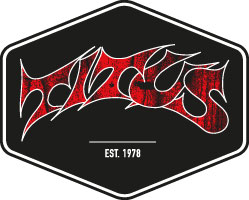TRUCKS ARE, BY FAR, THE MOST COMPLEX COMPONENT OF THE SKATEBOARD
Even though there hasn't been much change in steering technology itself, due to the many manufacturers, a wide variety of materials have established themselves. In the following, we explain the various components inside a skateboard truck in order to make you understand why shifting your body weight causes the board to change the direction.
Baseplate
The baseplate (-> fig. 01A) is the basis of the truck. It is attached to the deck using four bolts. Anchored in the baseplate are the kingpin (-> fig. 01C) and the pivot cup (-> fig. 01H). The four holes are for the bolts, which connect the truck to the deck. They are standardized and all the trucks by well-known manufacturers fit under current decks.
Kingpin
The kingpin bolt (-> fig. 01C) is firmly positioned inside the baseplate and serves as the connecting piece between the baseplate and the hanger. The kingpin nut (-> fig. 01I) holds everything together. Nowadays, kingpins are available in hollow versions, which reduce the weight of the truck.
Bushings
The bushings (-> fig. 01D) are placed around the hanger and the kingpin. They carry the weight of the rider, which is why it is very important to have a proper set-up of hardness grade and tightening of the kingpin nut (-> fig. 01I). Usually, heavier riders choose hard bushings while lightweight riders choose soft bushings. Bushings are available with hardness grades between 80A (extremely soft) and 100A (extremely hard).
Axle
The axle (-> fig. 01E) is cast into the hanger horizontally. The wheels including the bearings are placed on the two visible ends of the axle. The outer ends feature threads, which hold the axle nuts. If one of the threads is reaching its wear limit, there are skate-tools with a built-in thread-cutter, which renew the thread. By now, the axle is also available in a hollow version.
Sizes
Almost all truck manufacturers have their own size-chart. Practically speaking, this means that an 8'' deck can be equipped with an Independent 139, a Thunder 147, or a Titus 5.3. The table on the right shows you exactly which trucks fit your deck perfectly.
Low oder High
Die meisten Achsen werden in zwei Ausführungen angeboten, nämlich als low (niedrig) und high (hoch). In manchen Fällen wird auch eine Medium-Variante (mid) angeboten. In der High-Variante wird sowohl der Abstand zwischen Rolle und Deck als auch zum Boden vergrößert. Dadurch kannst du größere Rollen und engere Kurven fahren. Zudem kannst du deine Achsen weicher stellen, ohne einen Wheelbite zu kassieren.




